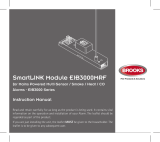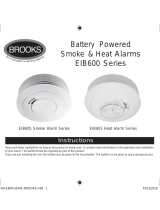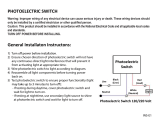Page is loading ...

EIB3024 / 3016 / 3014
Alarms
Instruction Manual
Mains Powered
Read and retain carefully for as long as the product is being used. It contains vital
information on the operation and installation of your Alarm. The leaflet should be
regarded as part of the product.
If you are just installing the unit, the leaflet MUST be given to the householder. The
leaflet is to be given to any subsequent user.

2

3
Contents
Installer Guide 5
1. Introduction 5
1.1 Overview 7
1.2 Technical Specifications 9
2. Installation 11
2.1 Important Safety Instructions 12
2.2 Where to locate the Alarm? 13
2.3 Which Alarm in what room? 17
2.4 Where in the room? 18
2.5 Locations to avoid 20
2.6 Mounting and wiring 22
2.7 Interconnecting Alarms 26
2.8 Removing the Alarm 28

4
User Guide 29
3. Testing 29
3.1 Testing and maintaining your Alarm 30
3.2 Cleaning your Alarm 32
4. What to do in case of alarm 34
5. Troubleshooting and Indicator summary tables 36
6. Important safeguards 44
7. Service and Guarantee 47
7.1 Getting your Alarm serviced 48
7.2 Guarantee 48

5
1
Introduction
Installer Guide

6
The EIB3024 is a Multi-Sensor Alarm with heat enhanced photoelectric smoke sensor and automatic
dust compensation, delivering a faster response to a wider range of fires. It detects both smoke and
heat from a fire and is ideal for hallway, landing, living room and bedroom areas.
The EIB3016 is an Photoelectric Smoke Alarm, with a proven optical sensor and automatic dust
compensation delivering a fast response to smouldering fires. It is ideal for hallway, landing and
living room areas.
The EIB3014 is a Heat Alarm with a Class A1 heat sensor. It can only to be used as part of a an
interconnected alarm system, i.e. interconnected with Brooks mains powered Multi-Sensor or Smoke
Alarms. It is ideal for kitchens, garages, boiler houses and other areas where there are normally high
levels of fumes, smoke or dust i.e. places where Multi-Sensor or Smoke Alarms cannot be installed
without the risk of excessive nuisance alarms.
Up to 12 Alarms can be interconnected so that if one senses fire, all Alarms sound. It can be a
hardwired interconnection, a wireless interconnection or a mixture of both (for the wireless option
an EIB3000MRF SmartLINK module needs to be added to each Alarm – sold separately).
The EIB3000 series is supplied with a mounting plate that allows very quick and simple installation
of the Alarm. The mains and battery power is automatically connected as the Alarm slides onto the
mounting plate. Each Alarm comes with built-in rechargeable backup batteries to power the Alarm
in the event of a mains failure.
AudioLINK
The EIB3000 series Alarms are AudioLINK enabled. This feature allows the user to download
information from the Alarm through the use of a mobile App. For more information on using this
feature, please refer to the relevant section on www.eielectronics.com or www.brooks.com.au

7
1.1 Overview
Red LED
Alarm Indicator
Yellow LED
Fault Indicator
Green LED
Power Indicator
Test / Hush Button Alarm Sounder
EIB3014 Heat AlarmEIB3016 Photoelectric Alarm
Heat Sensor
(Thermistor)
RF Module
LED Indicator
RF Module
Learn Switch
Alarm
Removal
Latch
Smoke Entry
Vents
RF Module
LED Indicator
RF Module
Learn Switch
Alarm
Removal
Latch
Heat Sensor
(Thermistor)
Smoke Entry
Vents
RF Module
LED Indicator
RF Module
Learn Switch
Alarm
Removal
Latch
EIB3024 Multi-Sensor Alarm

8
Red LED
Alarm Indicator
Yellow LED
Fault Indicator
Green LED
Power Indicator
Test / Hush Button Alarm Sounder
EIB3014 Heat AlarmEIB3016 Photoelectric Alarm
Heat Sensor
(Thermistor)
RF Module
LED Indicator
RF Module
Learn Switch
Alarm
Removal
Latch
Smoke Entry
Vents
RF Module
LED Indicator
RF Module
Learn Switch
Alarm
Removal
Latch
Heat Sensor
(Thermistor)
Smoke Entry
Vents
RF Module
LED Indicator
RF Module
Learn Switch
Alarm
Removal
Latch
EIB3024 Multi-Sensor Alarm

9
Smoke Sensor
Photoelectric (EIB3024 and EIB3016)
Heat Sensor
Thermistor Class A1 (EIB3014 and EIB3024)
Power Supply
230V AC, 50Hz, 0.25W
Battery Backup
Built-in 10-year rechargeable Vanadium Pentoxide Lithium cells. Fully
charged, the battery will provide up to 6 months (without module
fitted) or 3 months (with module fitted) back-up without mains power
Alarm Sounder
Piezoelectric Horn
Alarm Sound Level
85dB(A) at 3 meters (min)
Memory Feature
Indicates that the Alarm has previously detected fire
Self Test
Sensors, batteries and electronics are automatically tested periodically
Test/Hush Button
Checks sensors, electronics, interconnection and sounder.
If the unit is in alarm when pressed, it silences the alarm for 10min
Visual indicators
Green LED – Power supply Yellow LED – Fault, EOL
Red LED – Memory or alarm (if coincides with horn sounding)
AudioLINK
Enabled
Operational Life
10 years
1.2 Technical Specifications

10
Interconnection
Up to 12 units can be interconnected via a hardwired or wireless
system (using optional EIB3000MRF SmartLINK module)
Fixings
Supplied with Easi-fit anti-tamper mounting plate with integral
terminal block and wiring cover, includes screws and wall plugs
Operating Temperature
Normal: -10°C to +40°C (Storage: -10°C to +40°C) *
Humidity Range
15% to 95% RH (non-condensing)
Plastic Material
UL94V-0 flame retardant rated
Dimensions
EIB3024 and EIB3014: Product: - Ø150mm x 66mm
Package - 155mm x 155mm x 70mm
EIB3016: Product: - Ø150mm x 63mm
Package - 155mm x 155mm x 65mm
Weight
350g (including packaging)
Warranty
5 year (limited)
Approvals
Conforms to AS3786:2014 and AS1603.3:2018
* Temperature and Humidity conditions are for normal operation and storage. Units will function outside
these ranges as required by the specific product Standards. Extended exposure to conditions outside
these ranges can reduce product life. For advice on prolonged operation outside these ranges consult
the manufacturer.

11
2
Installation

12
2.1 Important Safety Instructions
Mains operated Alarms should be installed and interconnected by a licensed electrician
in accordance with the relevant Regulations for Electrical Installations. Failure to install this
Alarm correctly may expose the user to shock or fire hazards and damage the product.
The Alarm is designed to be permanently mounted, using it’s own built-in terminal block
to connect it to the mains. The mounting plate can be screwed directly to the ceiling.
Alternatively it can be screwed to a junction box. The Alarm must not be exposed to dripping
or splashing. There are important markings on the underside of the Alarm.
Alternative Energy Sources - (Wind, Solar, UPS etc.)
This product is designed to be connected to a Pure or True Sine Wave 230V AC supply.
If connecting to a power source that utilises an inverter, e.g. PV solar panel, the Total Harmonic
Distortion (THD) must be less than 5%. If in doubt please check with the manufacturer of the
inverter. This also applies to battery powered UPS (Uninterruptible Power Supply) inverters.
Light Dimmer Circuits – The Alarms must not be powered from a light dimmer circuit.
Do not install Alarms in new or renovated buildings until all work is completed.
The Alarm must not be connected when the house wiring insulation is being checked with
high voltages. i.e. Do not use a high voltage insulation tester on the Alarm.

13
The Alarm must be continuously powered 24 hours a day so it is important that it is not on a
circuit that can be turned off by a switch.
The power supply for the Alarms should be derived from the public electricity supply to the
dwelling. The mains supply to the Alarms should take the form of either:
(a) an independent circuit at the dwelling’s main distribution board, in which case no
other electrical equipment should be connected to this circuit (other than a dedicated
monitoring device installed to indicate failure of the mains supply to the Alarms); or
(b) the non-switched side of a separately electrically protected, regularly used local lighting
circuit. Alarms should be connected on a single final circuit, unless the means of
interconnection is by radio signals (e.g. RadioLINK).
2.2 Where to locate the Alarm
The main reason for fitting Smoke/Heat/Multi-Sensor Alarms in dwellings is to ensure that when
there is a fire, sufficient early warning is given so that everybody can escape safely. This means that
the Alarms should ideally be located near all potential sources of fires and that the alarm should be
heard throughout the house – particularly in the bedrooms.
It is also important that nuisance/false alarms are minimised to ensure the Alarms are not disabled
or ignored.

14
A single Smoke Alarm will give some protection if it is properly installed, but most homes will require
two or more to ensure that a reliable early warning is given. For recommended protection you should
put individual Smoke Alarms in all rooms where fire is most likely to break out (apart from the kitchen
and bathroom).
The Building Code of Australian, state and territory building regulation and AS1670.1 give the
guidance on:
- how many Alarms to install
- what type of Alarm to use
- where to position Alarms
The above points will depend on the type of dwelling and class of building to be protected and the
level of fire risk.
Fire Risk Assessment
The type of system that should be installed depends on the fire risk. It is therefore recommended
that a Fire Risk Assessment is undertaken. The Risk Assessment would be based on a combination
of probabilities:
- fire occurring
- injury or death to occupant
- system operating correctly with a fire
- early detection and warning to occupants in the event of a fire.
The greater the risks, the more comprehensive and reliable systems needs to be.

15
Smoke Alarms located as across plus:
Bedroom
Bedroom
Bedroom
Bathroom
Bath
Dining Room
Laundry
Room
Living Room
Kitchen

16
Smoke Alarms located as across plus:
Bedroom
Bedroom
Bedroom
Bathroom
Bath
Dining Room
Laundry
Room
Living Room
Kitchen

17
2.3 Which Alarm in what room?
Location
EIB3024
Mutil-Sensor
Alarm
EIB3016
Photoelectric
Smoke Alarm
EIB3014
Heat
Alarm (i)
Hall, Corridors, Escape routes
✔ ✔ ✗
Kitchens / Garages
✗ ✗ ✔ (iii)
Living Rooms
✔ ✔ ✔ (ii)
Bedrooms
✔ ✔ ✗
Shower / Bathrooms
✗ ✗ ✗
(i) A Heat Alarm should only be used in a room adjoining an escape route, in conjunction with
Multi-Sensor Alarms or Smoke Alarms on the escape routes. All the Alarms should be
interconnected to ensure the early warning will be heard.
(ii) Where Heat Alarms replace a required Smoke Alarm due to an unacceptable level of nuisance
alarms, Smoke Alarms must be installed in other locations within the dwelling to ensure effective
early warning. Heat Alarms must be interconnected to installed Smoke or Multi Alarms.
(iii) In enclosed kitchens with doors closed.

18
2.4 Where in the room?
The locations must comply with the Building Code of Australian, state and territory legislation and
the instructions in this leaflet.
<600mm
HEAT ALARMS
<150mm
SMOKE /
MULTI-SENSOR
ALARMS
APEX
xx
300mm
300mm (min)
Ceiling Mounting
Hot smoke rises and spreads out, so a central ceiling position is the preferred location. The air is
“dead” and does not move in corners, therefore Alarms must be mounted away from corners. Fit
the Alarm:
- At least 300mm away from walls (see Figure 1).
- At least 300mm from any light fitting or decorative object which might obstruct smoke / heat
entering the Alarm.
Fig.1

19
Fig.2
500 mm
1500 mm max.
300 mm
min.
Ceiling line
Exposed oor joists
Side Wall
DEAD AIRSPACE AND PROPER MOUNTING OF SMOKE ALARMS ON SIDE WALLS
300 mm
500 mm max.
min.
Dead air space
Suitable smoke
alarm location
Key:
Wall Mounting (EIB3016 only)
If ceiling mounting is impractical, only the EIB3016 Photoelectric Smoke Alarm may be mounted on
a wall, provided that:
a) the top of the detection element is between 300mm and 500mm below the ceiling (see Figure 2);
b) the bottom of the detection element is above the level of any door openings;

20
Wall mounting should only be considered where close spaced beams or similar obstructions may
preclude ceiling mounting. It is considered to be the responsibility of the installer/client to determine
if the presence of asbestos in the ceiling material would make ceiling mounting ‘impractical’.
Sloping Ceiling
With a sloping or peaked ceiling install a Smoke or Heat Alarm between 500mm min. and 1500mm
max. of the peak (measured vertically). If this height is between 300mm min. and 500mm max. for
Smoke Alarms or for Heat Alarms it is regarded as being flat (see Figure 2).
2.5 Locations to avoid
DON’T place Smoke, Heat or Multi-Sensor Fire Alarms in any of the following areas:
• Bathrooms, shower rooms or other rooms where the Alarm may be triggered by steam, condensation.
• Places where the normal temperature can exceed 40°C or be below -10°C (e.g. furnace rooms,
directly above ovens or kettles etc.) as the heat/steam could cause nuisance alarms.
• Near a decorative object, door, light fitting, window moulding etc., that may prevent heat or smoke
from entering the Alarm.
• Surfaces that are normally warmer or colder than the rest of the room (e.g. attic hatches).
Temperature differences might stop heat or smoke from reaching the Alarm.
• Next to or directly above heaters or air conditioning vents, windows, wall vents etc. where air
draughts can change the direction of airflow and cause rapid temperature fluctuations.
• In very high or awkward areas (e.g. over stairwells) where it may be difficult to reach the Alarm
(for testing, hushing etc.).
/










